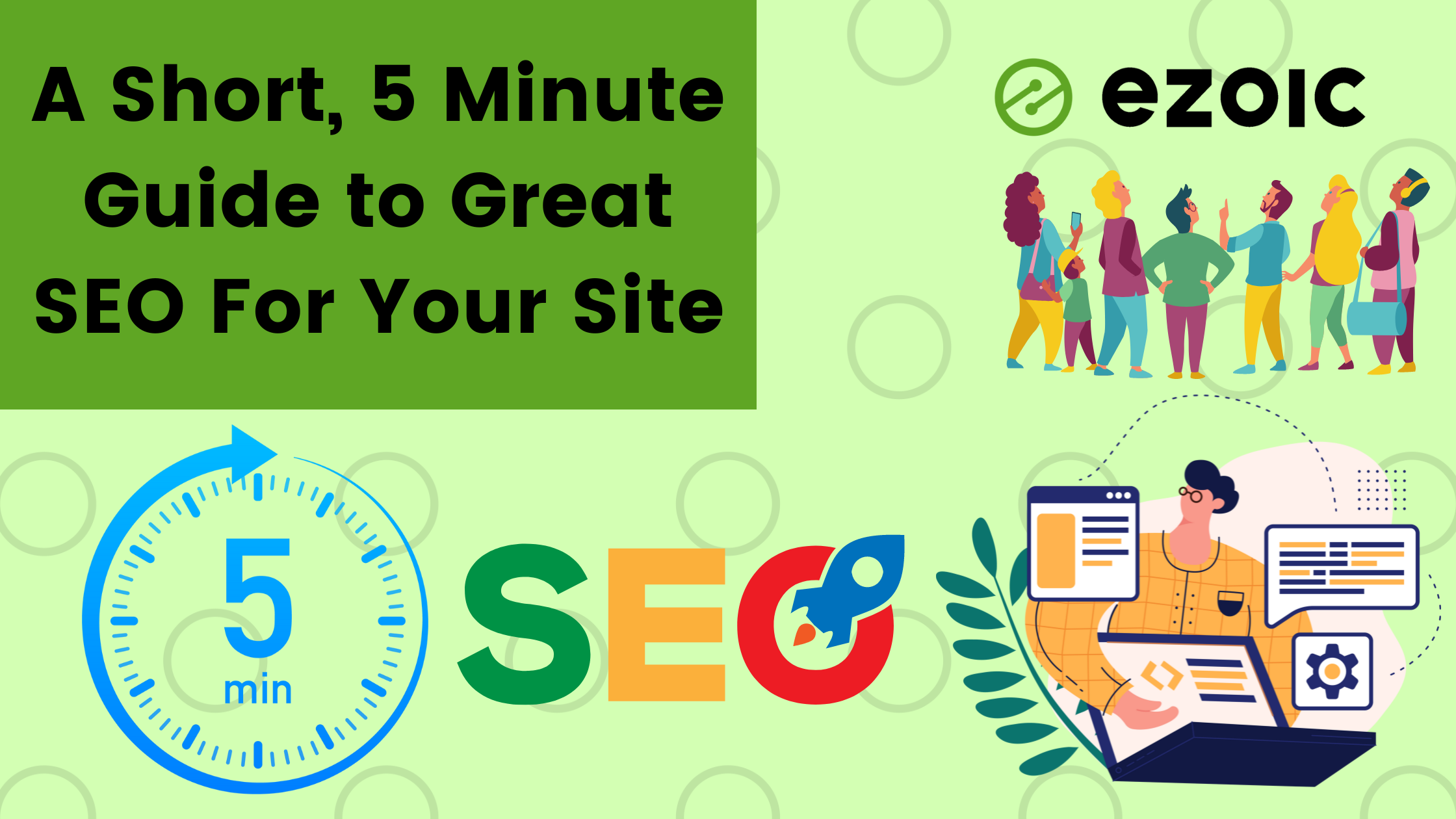There’s only so much I can say in 5 minutes, so I’ll be brief. I could talk all day, all week about this. This article is all about teaching you some of the most basic SEO strategies to help your site grow, as fast as possible.
For more information, download our official Ezoic SEO eBook, which goes into far greater detail and has already helped thousands of publishers create better SEO for their site.
1. Satisfy Intent
I’m not going to get stuck in the weeds in this article, giving tips for granular and specific SEO situations. That stuff doesn’t really matter if you haven’t taken care of the big picture of your site: satisfying the intent of your audiences’ search.
As SEO agency Backlinko explains, “Search Intent (also known as ‘User Intent’) is the main goal a user has when typing a query into a search engine. Common types of Search Intent include informational, commercial, navigational and transactional.” SEO agency Moz puts it plainly this way: “Satisfying search is the primary goal for Google.” This is critically important, and all the advanced SEO tricks in the world can’t save a site that doesn’t satisfy search intent.
Put yourself in the place of your audiences’ shoes. They’ve just typed in a query into Google, and an article from your site pops up. They click on it.
Does it answer their question? Or will they click away because your content is too long (or too short), doesn’t answer the question, or just isn’t that helpful?
This is high-level thinking, and it’s not easily explained. But beyond the world of SEO tools and site management strategies, the simple questions are always available: does your site actually help people?
You can see more analysis with tools like Google Analytics or Ezoic’s Big Data Analysis tool.

2. Create At Least 5 Events Your Audience Will Experience
When your audience finds your site, there are dozens of unconscious choices they make instantly. Great SEO can help with this, but essentially, it’s on you to make a site where your audience will really want to stay and explore. If you can do this right, your whole site benefits; Google recognizes people stay on your site longer, your audience gets a chance to see more of who you are, and maybe even considers buying a product or subscribing, all of which leads to more revenue.
This works best. if you have a plan in mind for your audience. Wherever they come from, whatever content they click on, you’ll want to have a next step (or several next steps). This maximizes your ability to create return visitors through subscribers, increase your ad revenue through audience time on page, etc.
Here’s a sample 5-step sequence for a site:
- Step 1: Someone clicks on an article from your site
- Step 2: They click on your homepage or About page to see what the site is about
- Step 3: They see a free giveaway in exchange for their email
- Step 4: They subscribe to your email list
- Step 5: They’re sent an automatic email containing your site’s most popular content
Here’s another sample sequence:
- Step 1: Someone clicks on an article from your site
- Step 2: They click on a new article that is related to their original query
- Step 3: They see you have an active social media channel with more personalized content
- Step 4: They go to your social media channel and see any pinned/highlighted content you want to show newcomers
- Step 5: They follow you on social media
Whatever your plan is, just make sure you have one. Just like professional tennis players plan out several hits before they even serve the ball, you must plan out several events your audience will experience when they first interact with your site. Plan out the ideal sequence of events your audience will go through, so you can maximize your engagement and revenue.

3. Use an SEO Plugin Tool (or Tools)
There are a plethora of great SEO tools out there, including several Ezoic ones. No matter what tool(s) you decide to use, you need to be using SEO tools. There’s simply too much data, algorithm behavior, and market changes to understand all by yourself.
Ezoic’s very own Tag Tester and Broken Links tool are excellent examples of great SEO tools: you can use Tag Tester to, well, test tags on your site! This is great for determining which title and header tags perform the best and attract the most organic traffic. The Broken Links tool quickly assesses your entire site and alerts you if and when any of your site pages go down, so you can quickly fix them.
Other plugins quickly tell you how SEO-friendly your article content is before you post it, whether you should include more/less videos, keywords, pictures, internal/external links, etc. If this all sounds basic to you, great! You’re on track to have great SEO. If you’re still learning, SEO tools cover an enormous amount of SEO strategies you can quickly adopt on your site today.
4. Create a Top-10 List of Long Tail Keywords You’d Like to Rank For
As our in-house SEO specialists would be quick to tell you, if you don’t have a target, there’s no way to know if you’re winning.
Most small sites have no chance at ranking for popular, short tail keywords in their niche; As Search Engine Journal reveals, “The first organic result in Google Search has an average click-through rate of 28.5%.” That’s a lot of traffic going to a very small number of search results, meaning if you don’t find a way to rank highly, odds are you’ll never see the large amount of traffic you really want.
Here’s an example. If you write about car maintenance tips, there are hundreds of other highly active, proven sites that are ranking for major keywords like “how to fix your car” or “car maintenance tips.” If you try and rank for these keywords, you’re undoubtedly lose to these bigger, stronger publishers.
Instead, you’d do well to focus on smaller, long tail keywords, proving to Google that you write great content. You’ll also actually appear in queries with these keywords. Even if they’re not highly trafficked (a couple thousand global queries a month vs. a couple hundred thousand), you can still begin getting steady traffic. This will help you greatly in the future when you do begin trying to rank for more competitive keywords.
5. Do a Short, Competitive Analysis Between Your Site and a More Successful Competitor’s Site
Conducting a comparative analysis between your site and a more successful competitor’s site is a simple, proven strategy to begin building a more successful site yourself.
Odds are, your more successful competitors have spent more time online, done more market research, and learned more insights about their niche. Instead of wasting months or years learning the same lessons, you can learn from your competitors — and one-up them with creating a better site than theirs.
If they consistently write 1500-word articles, consider writing 1750-word articles. If they use 7 pictures per post, consider using 10 yourself. If they post twice a week, consider posting 3 times. You’re asking yourself the same questions: what are your competitors doing, and how can you do it better?
This is a powerful one-two punch when it comes to creating better SEO strategies and applying them to your site.

In Conclusion
This is the most basic SEO guide I could possibly create, and I’ve only scratched the surface for what’s important and what you need to know. Fortunately, Ezoic has a whole suite of SEO tools and website tools to help with this.
Great SEO can (and often does) make or break sites. If you can’t consistently get organic traffic to your site, your site probably won’t thrive — or survive — for long. There comes a time when putting in an hour of work can multiply your site’s revenue tremendously; that’s how powerful great SEO strategies can be. If you haven’t already, take some time to apply these basic SEO strategies to your site.


